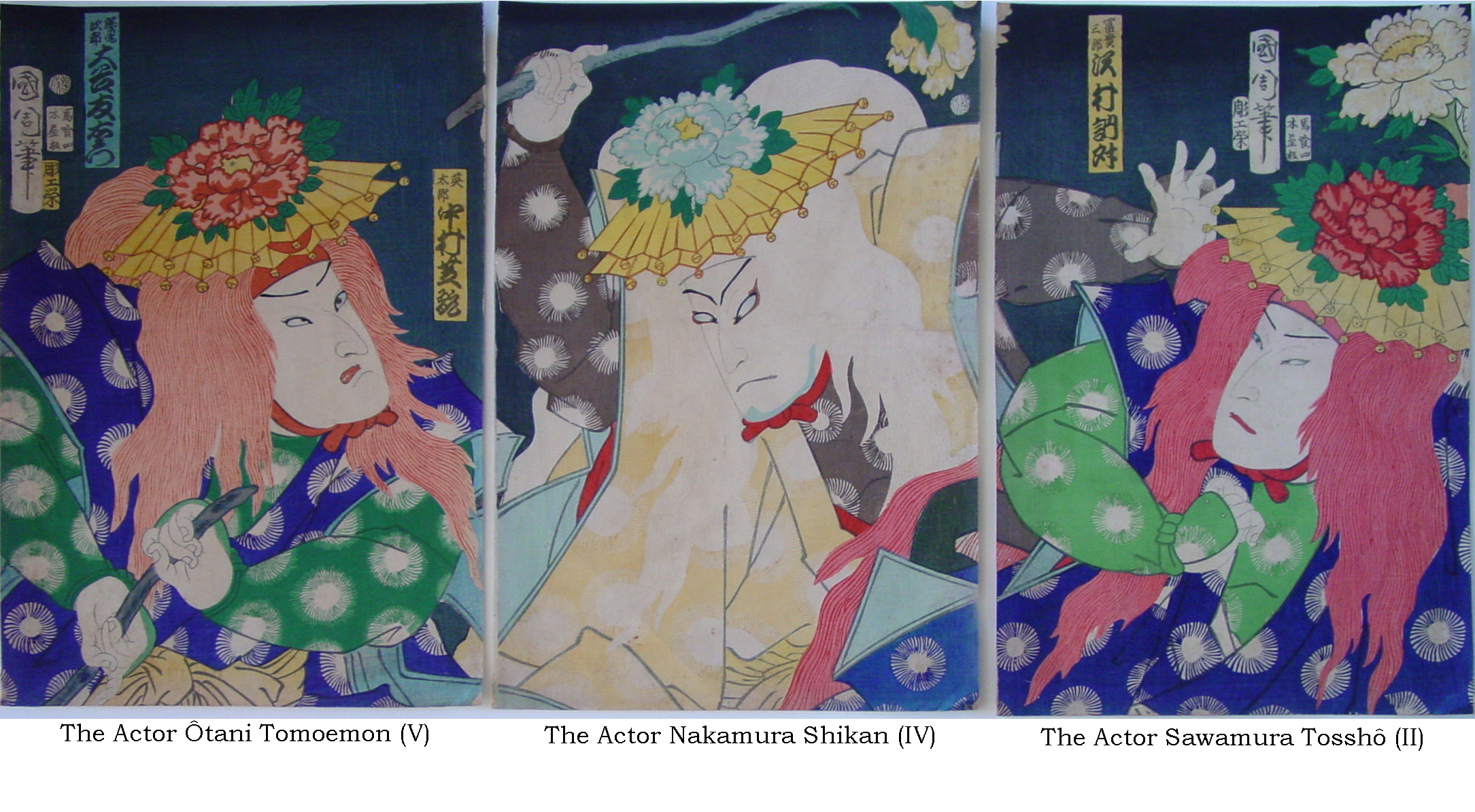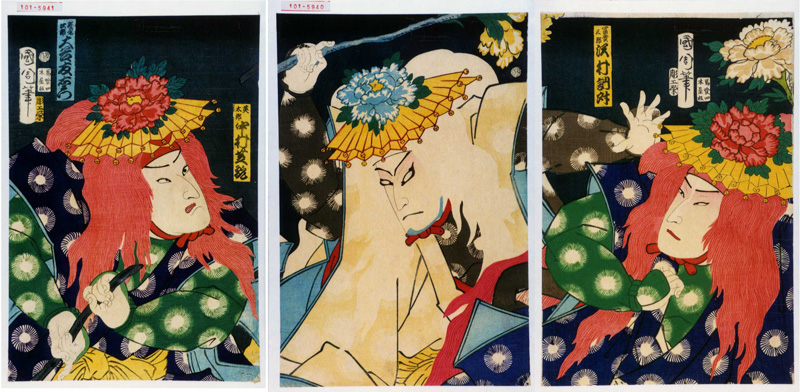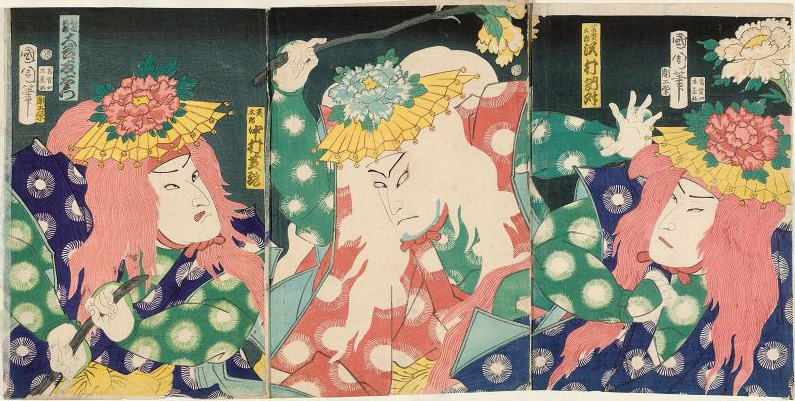About This Print
The three actors (R to L) Sawamura Tosshō II, Nakamura Shikan IV, and Ōtani Tomoemon V are shown dancing in lion wigs and peony (botan) hats. Nakamura Shikan in the white wig is performing the dance with his two cubs in the red wigs. He brandishes a peony branch in what has been described as a "heaven-earth" pose. Each actor's head is adorned with a peony on top of two open fans. While I do not know which lion dance (Shishimai 獅子舞) is being performed, the following song from the kabuki play "Two Lions" feels appropriate to the scene:The time has come for the lions / to dance to ancient tunes!
The time has come for the lions / to dance to ancient tunes!
The cups of the peony blooms / now overflow with fragrance!
Exhibiting their massive strength, / here the lion head!
Beat the drums! Let music play / The peony's scent! The peony's scent!
The flowers' golden stamens / emerge from within.
Sporting among the blossoms, / tumbling among the branches,
Surely nothing can surpass / the lions' fierce majesty.
Even among the trees and grasses / there are none that will not bow.
Long may their dance continue, / a thousand autumns!
Long may their dance continue, / a thousand autumns!1
Note that this print exists in at least two states as can be seen by the difference in colors of Nakamura Shikan's robe in the center panel of the two prints below.
1 Kabuki Plays on Stage: Restoration and Reform, 1872-1905, James R. Brandon, Samuel L. Leiter, University of Hawaii Press, 2003, p. 53-53
The Nō Drama Shakkyō - Origin of the Kabuki Lion Dance
Source: English language guide to Narukami and Shunkyo Kagami Jishi at the Salle Garnier Opera Monaco 16-19, September 2009In Skakkyo 石橋 (Stone Bridge), a famous noh drama later adapted as a dance for the kabuki stage, a Buddhist priest visits mount Seiryo in China and sees a lion (shishi) playing with peonies. In the East peonies (botan) are associated with butterflies and lions.
Other Images
The Actors Pictured
Source: Kabuki 21 website http://www.kabuki21.com/takasuke4.phpSawamura Tosshô II (1838 ~ 2 February 1886) was the stage name for Suketakaya Takasuke IV. He was the worthy heir of his father Sawamura Sôjûrô V, excelling in wagotoshi, wajitsu or onnagata roles. He shared the stage with the Meiji giants Ichikawa Danjûrô IX and Onoe Kikugorô V. He posthumously received the name of Sawamura Sôjûrô VI.
Source: Kabuki 21 website http://www.kabuki21.com/shikan4.php
Nakamura Shikan IV (3 March 1831 ~ 16 January 1899) was a great Meiji actor, who achieved fame for himself all over Japan (he toured a lot). He was equally at home in sewamono and jidaimono dramas, able to play almost any kind of role as tachiyaku, katakiyaku or even onnagata. He created many kata and some of them are still sometimes revived, like the ones for the role of Kumagai Jirô Naozane in the "Kumagai Jin'ya" scene of the classic "Ichi-no-Tani Futaba Gunki".
His rivalry with Bandô Hikosaburô Vwas one of the hottest in Kabuki history: "So nearly matched in abilitywere Shikan and Hikosaburô, with but two years' difference in theirages, that they were pitted against each other, and their patrons oftenindulged in fights over them. During a performance, when these actorswere playing together, they came through the audience by way of the twohanamichi, the one to the right of the stage a mere footpath, that to the left a platform that was in reality a continuation of the stage proper. They quarrelled as to who should take the main hanamichi, and the dispute waxed so hot that they finally drew lots to settle the matter." (Zoë Kincaid in Kabuki, the Popular Stage of Japan)
Source: Kabuki 21 website http://www.kabuki21.com/hiroji5.php
Ôtani Tomoemon V (1833 ~ 1 February 1873) was the stage name of Ôtani Hiroji V from 1865 to August 1869, then a second time from April 1871 to February 1873. He was an overweight actor, able to play tachiyaku, katakiyaku, oyajigata or onnagata, in both jidaimono and sewamono.
Print Details
| IHL Catalog | #301 |
| Title (Description) | Actors Sawamura Tosshō (II) as Fuki Saburō (R), Nakamura Shikan (IV) as Hidetarō(C), and Ōtani Tomoemon (V) as Jirō (L) |
| Artist | Toyohara Kunichika (1835–1900) |
| Signature | Kunichika hitsu (right and left sheets) |
| Seal | none |
| Publication Date |  |
| Publisher |  seal reading:馬喰四 木屋板 Bakuro Yon , Kiya han [Marks: pub. ref. 252; seal ref. 26-143] |
| Carver |  |
| Impression | excellent |
| Colors | excellent |
| Condition | good - trimmed to image; foxing center sheet and minor soiling |
| Genre | ukiyo-e - nigao-e; yakusha-e |
| Miscellaneous | |
| Format | vertical oban triptych |
| H x W Paper | 13 3/4 x 9 1/2 in. (34.9 x 24.1 cm) each sheet |
| Literature | |
| Collections This Print | Waseda University Tsubouchi Memorial Theatre Museum 101-59393; Museum of Fine Arts, Boston 11.41777a-c; Hagi Yamaguchi Prefectural Museum U03845 |




